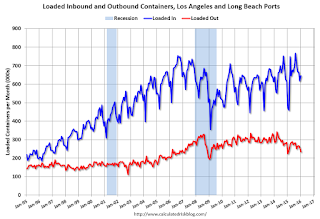by Calculated Risk on 2/14/2016 10:46:00 AM
Sunday, February 14, 2016
LA area Port Traffic Increased YoY in January, Busiest January in LA Port History
Note: There were some large swings in LA area port traffic early last year due to labor issues that were settled in late February. Port traffic slowed in January and February last year, and then surged in March 2015 as the waiting ships were unloaded (the trade deficit increased in March too). This will impact the YoY changes for the first few months of 2016.
From the Port of Los Angeles: Port of Los Angeles January Volumes increase 33%; 704,398 TEUs Busiest January in Port History
The Port of Los Angeles handled 704,398 Twenty-Foot Equivalent Units (TEUs) in January 2016, an increase of 33 percent compared to January 2015. It was the busiest January in the port’s 109-year history. ...Container traffic gives us an idea about the volume of goods being exported and imported - and usually some hints about the trade report since LA area ports handle about 40% of the nation's container port traffic.
"Record January volumes is a very encouraging way to start 2016, particularly after the slow start that West Coast ports experienced last year," said Port of Los Angeles Executive Director Gene Seroka.
The following graphs are for inbound and outbound traffic at the ports of Los Angeles and Long Beach in TEUs (TEUs: 20-foot equivalent units or 20-foot-long cargo container).
To remove the strong seasonal component for inbound traffic, the first graph shows the rolling 12 month average.
 Click on graph for larger image.
Click on graph for larger image.On a rolling 12 month basis, inbound traffic was up 2.2% compared to the rolling 12 months ending in December. Outbound traffic was up 0.3% compared to 12 months ending in December.
The recent downturn in exports is probably due to the strong dollar and weakness in China.
The 2nd graph is the monthly data (with a strong seasonal pattern for imports).
 Usually imports peak in the July to October period as retailers import goods for the Christmas holiday, and then decline sharply and bottom in February or March (depending on the timing of the Chinese New Year).
Usually imports peak in the July to October period as retailers import goods for the Christmas holiday, and then decline sharply and bottom in February or March (depending on the timing of the Chinese New Year). Imports were up sharply year-over-year in January; exports were up 5% year-over-year. This suggests a larger trade deficit with the Far East in January.


